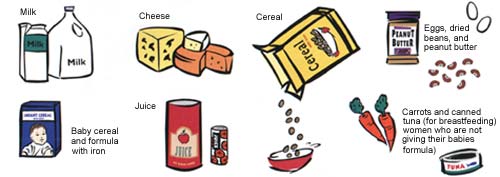|
Here you'll find information about Women Infant Children
(WIC)...

WIC
The Special Supplemental Nutrition Program
for Women, Infants and Children
1. What is WIC?
WIC provides nutritious foods, nutrition education, and referrals to health and
other social services to participants at no charge. WIC serves low-income pregnant, postpartum and breastfeeding women, and
infants and children up to age 5 who are at nutrition risk.
WIC is not an entitlement program; that is, Congress does not set aside
funds to allow every eligible individual to participate in the program. Instead, WIC is a Federal grant program for which
Congress authorizes a specific amount of funding each year for program operations. The Food and Nutrition Service, which administers
the program at the Federal level, provides these funds to WIC State agencies (State health departments or comparable agencies)
to pay for WIC foods, nutrition education, and administrative costs.
2. Where is WIC available?
The program is available in all 50 States, 34 Indian Tribal Organizations,
America Samoa, District of Columbia, Guam, Commonwealth Islands of the Northern Marianas, Puerto Rico, and the Virgin Islands.
These 90 WIC State agencies administer the program through 2,200 local agencies and 9,000 clinic sites.
3. Who is eligible?
Pregnant or postpartum women, infants, and children up to age 5 are
eligible. They must meet income guidelines, a State residency requirement, and be individually determined to be at "nutrition
risk" by a health professional.
To be eligible on the basis of income, applicants’ income must
fall at or below 185 percent of the U.S. Poverty Income Guidelines (currently $35,798 for a family of four). A person who
participates or has family members who participate in certain other benefit programs, such as the Food Stamp Program, Medicaid,
or Temporary Assistance for Needy Families, automatically meets the income eligibility requirement.
4. What
food benefits do WIC participants receive?
In most WIC State agencies, WIC participants receive checks or vouchers
to purchase specific foods each month that are designed to supplement their diets. A few WIC State agencies distribute the
WIC foods through warehouses or deliver the foods to participants’ homes. The foods provided are high in one or more
of the following nutrients: protein, calcium, iron, and vitamins A and C. These are the nutrients frequently lacking in the
diets of the program’s target population. Different food packages are provided for different categories of participants.
WIC foods include iron-fortified infant formula and infant cereal,
iron-fortified adult cereal, vitamin C-rich fruit or vegetable juice, eggs, milk, cheese, peanut butter, dried beans/peas,
tuna fish and carrots. Special therapeutic infant formulas and medical foods may be provided when prescribed by a physician
for a specified medical condition.
7. Who gets first priority for participation?
WIC cannot serve all eligible people, so a system of priorities has
been established for filling program openings. Once a local WIC agency has reached its maximum caseload, vacancies are filled
in the order of the following priority levels:
-
• Pregnant women, breastfeeding women, and infants determined
to be at nutrition risk because of a nutrition-related medical condition.
-
• Infants up to 6 months of age whose mothers participated
in WIC or could have participated and had a serious medical problem.
-
• Children at nutrition risk because of a nutrition-related
medical problem.
-
• Pregnant or breastfeeding women and infants at nutrition
risk because of an inadequate dietary pattern.
-
• Children at nutrition risk because of an inadequate dietary
pattern.
-
• Non-breastfeeding, postpartum women with any nutrition risk.
-
• Individuals at nutrition risk only because they are homeless
or migrants, and current participants who, without WIC foods, could continue to have medical and/or dietary problems.
For more information:
Information on FNS programs is available on the World Wide Web at www.fns.usda.gov/fns
Source: http://www.fns.usda.gov/wic/WIC-Fact-Sheet.pdf
|

